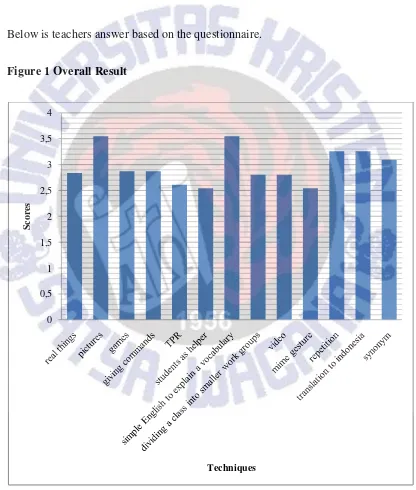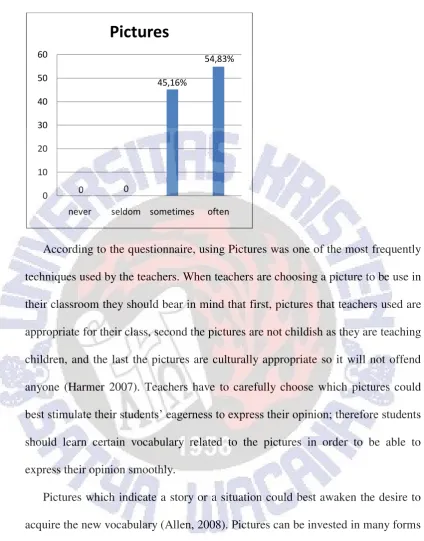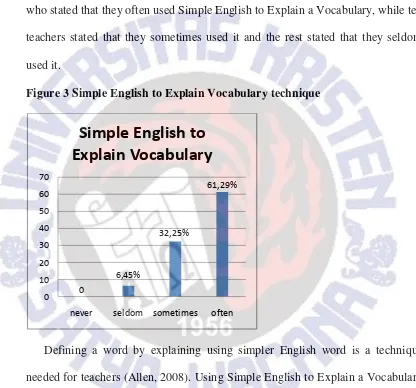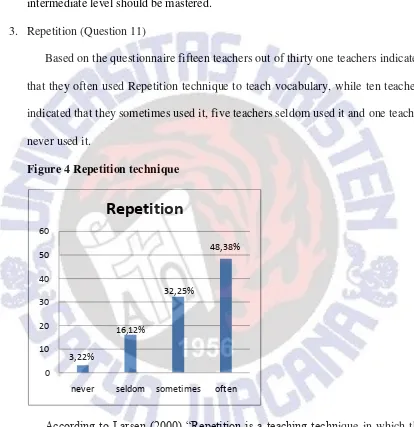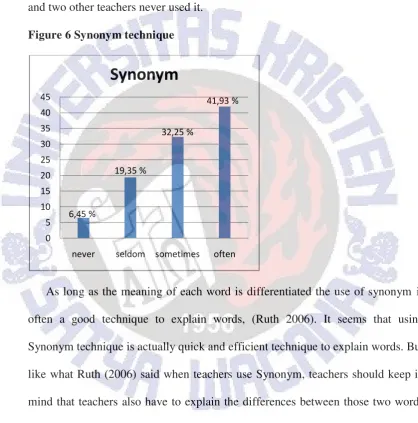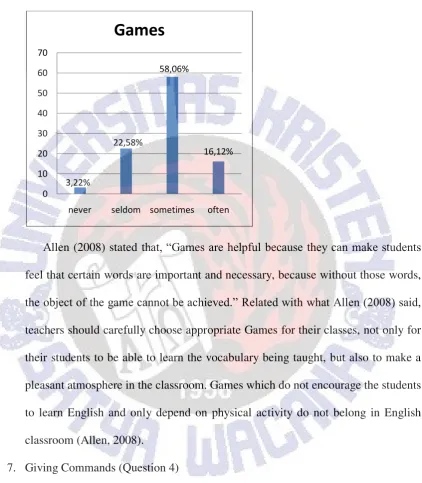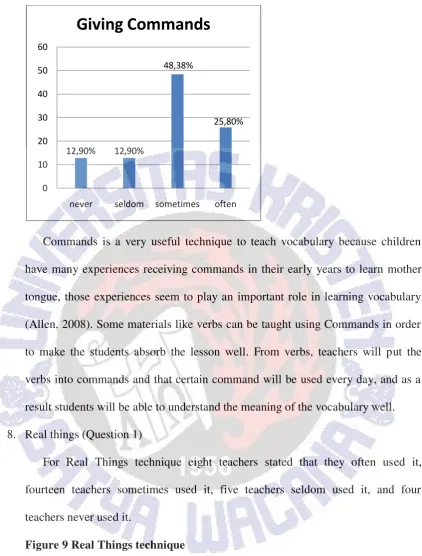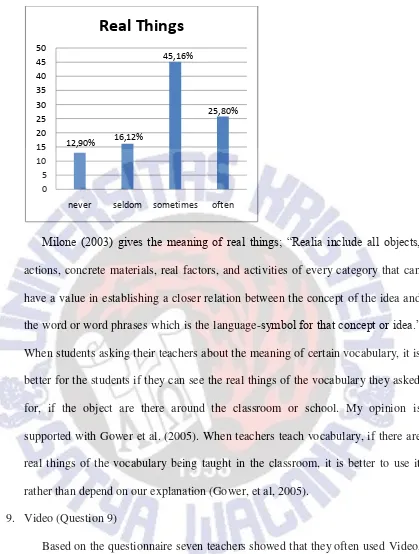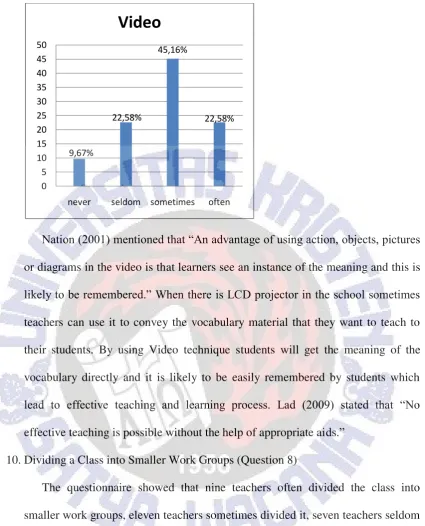Finding and Discussion
In this section I would like to describe the techniques that have been used by Junior High School English Teachers in Salatiga. There were thirteen techniques that Junior High School English Teachers used when they taught their students.
A. Overall results.
Below is teachers answer based on the questionnaire.
Figure 1 Overall Result
Based on the questionnaire result there were three techniques that English teachers in Salatiga most frequently used, Pictures, Simple English to Explain Vocabulary and
0 0,5 1 1,5 2 2,5 3 3,5 4
S
cor
es
Repetition. For Simple English to Explain a Vocabulary technique, from thirty one teachers there were nineteen teachers who stated that they often used it and ten teachers stated that they sometimes used it. For Pictures technique out of thirty one teachers there were seventeen teachers who stated that they often used Pictures and fourteen teachers stated that they sometimes used Pictures. While for Repetition technique there were fifteen teachers indicating that they often used it and tenth teachers stated that they sometimes used it. There were two techniques that English teachers in Salatiga least used, they were Mime Gesture and Students as Helper. For Mime and Gesture there were only four teachers stated that they often used it and fourteen teachers mentioned that they sometimes used it. There were five teachers indicating that they often used Students as Helper technique and fourteen teachers stated that they sometimes used it. The score meaning in the figure are as follows, score range 0.00-0.99 represents never used, 1.00-1.99 represents seldom, 2.00-2.99 represents sometimes and 3.00-4.00 represents often used the technique.
B. Techniques used by the teachers
These were the techniques that English teachers in Salatiga used from the most frequently to the least frequently used.
1. Pictures (Question 2)
Figure 2 Pictures technique
According to the questionnaire, using Pictures was one of the most frequently techniques used by the teachers. When teachers are choosing a picture to be use in their classroom they should bear in mind that first, pictures that teachers used are appropriate for their class, second the pictures are not childish as they are teaching children, and the last the pictures are culturally appropriate so it will not offend anyone (Harmer 2007). Teachers have to carefully choose which pictures could
best stimulate their students‟ eagerness to express their opinion; therefore students
should learn certain vocabulary related to the pictures in order to be able to express their opinion smoothly.
Pictures which indicate a story or a situation could best awaken the desire to acquire the new vocabulary (Allen, 2008). Pictures can be invested in many forms such as flash card, board drawing, LCD projector and etc. When teachers are using Pictures in Junior High School, teachers should aware that using pictures in junior high school is different than pictures that teachers used in elementary school or other lower grades. Based on Allen (2008) the best pictures to be used to
0 0
45,16%
54,83%
0 10 20 30 40 50 60
never seldom sometimes often
stimulate desire to learn new vocabulary is pictures which present a story a situation.
2. Simple English to Explain a Vocabulary (Question 7)
The second technique that the teachers most frequently used was Simple English to Explain a Vocabulary. There were nineteen teachers out of thirty one who stated that they often used Simple English to Explain a Vocabulary, while ten teachers stated that they sometimes used it and the rest stated that they seldom used it.
Figure 3 Simple English to Explain Vocabulary technique
Defining a word by explaining using simpler English word is a technique needed for teachers (Allen, 2008). Using Simple English to Explain a Vocabulary is not an easy technique. It requires many experiences in teaching English. Even though it is difficult, English teachers need to acquire this technique in order to stimulate their students to think in English and make their students get accustom with English.
students should only hear English from their teachers. Second, because in intermediate level there are many vocabulary that cannot demonstrate or shown using pictures, but through explanation of the teachers. Therefore Simple English to Explain a Vocabulary is an important technique that English teachers at intermediate level should be mastered.
3. Repetition (Question 11)
Based on the questionnaire fifteen teachers out of thirty one teachers indicated that they often used Repetition technique to teach vocabulary, while ten teachers indicated that they sometimes used it, five teachers seldom used it and one teacher never used it.
Figure 4 Repetition technique
According to Larsen (2000) “Repetition is a teaching technique in which the
students are asked to repeat the teacher‟s model as accurately and as quickly as
possible.” But in this study repetition did not only belong to repeating the same
model again and again. It seems that repetition of language play an important role in language learning because students as a learner will easily remember the vocabulary being taught, if they regularly used the same word again and again.
3,22%
16,12%
32,25%
48,38%
0 10 20 30 40 50 60
never seldom sometimes often
My opinion was in line with Harmer (2007) who stated that “The more repeated
encounters they have with it, the better chance they have of remembering (and
being able to use) it”.
4. Translation to Indonesia (Question 12)
Translation to Indonesia technique is the next favorite technique. There were seventeen teachers out of thirty one said that they often used Translation to Indonesia. Three teachers said that they sometimes used it, three teachers seldom used it and the last three teachers never used it.
Figure 5 Translations to Indonesia technique
Sometimes translation to source language was the most quickest and efficient way to explain some words rather than torturing unsuccessful explanation in English (Ruth, 2006). However using Translation to Indonesia technique is like
using „double edged sword‟. It has its own advantages but it also has its own
disadvantages. The advantage is like Ruth (2006) said “Sometimes it is the most
efficient way to explain some words”. On the other side it restricts the exposure of
English to the students (Harmer, 2007). What I can conclude is we have to limit the use of translation to source language in order to make the students accustomed
9,67% 9,67% 9,67%
54,83%
0 10 20 30 40 50 60
never seldom sometimes often
with English. Translate it into source language if the explanation takes time and it makes the students confused.
5. Synonym (Question 13)
Thirteen teachers agreed that they often used Synonym to teach vocabulary, while ten teachers agreed that they sometimes used it, six teachers seldom used it and two other teachers never used it.
Figure 6 Synonym technique
As long as the meaning of each word is differentiated the use of synonym is often a good technique to explain words, (Ruth 2006). It seems that using Synonym technique is actually quick and efficient technique to explain words. But like what Ruth (2006) said when teachers use Synonym, teachers should keep in mind that teachers also have to explain the differences between those two words to make sure their students will not confused and able to use each words properly. 6. Games (Question 3)
that they sometimes used Games, next seven teachers mentioned they seldom used Games and one teacher mentioned that he/she never used Games.
Figure 7 Games technique
Allen (2008) stated that, “Games are helpful because they can make students feel that certain words are important and necessary, because without those words,
the object of the game cannot be achieved.” Related with what Allen (2008) said,
teachers should carefully choose appropriate Games for their classes, not only for their students to be able to learn the vocabulary being taught, but also to make a pleasant atmosphere in the classroom. Games which do not encourage the students to learn English and only depend on physical activity do not belong in English classroom (Allen, 2008).
7. Giving Commands (Question 4)
From total thirty one teachers, there were eight teachers wrote that they often used Commands to teach vocabulary to their students, and fifteen teachers wrote they sometimes used Commands, four teachers seldom used it and the last four teachers never used it.
Figure 8 Giving Commands technique
Commands is a very useful technique to teach vocabulary because children have many experiences receiving commands in their early years to learn mother tongue, those experiences seem to play an important role in learning vocabulary (Allen, 2008). Some materials like verbs can be taught using Commands in order to make the students absorb the lesson well. From verbs, teachers will put the verbs into commands and that certain command will be used every day, and as a result students will be able to understand the meaning of the vocabulary well. 8. Real things (Question 1)
For Real Things technique eight teachers stated that they often used it, fourteen teachers sometimes used it, five teachers seldom used it, and four teachers never used it.
Figure 9 Real Things technique
12,90% 12,90%
48,38%
25,80%
0 10 20 30 40 50 60
never seldom sometimes often
Milone (2003) gives the meaning of real things; “Realia include all objects,
actions, concrete materials, real factors, and activities of every category that can have a value in establishing a closer relation between the concept of the idea and the word or word phrases which is the language-symbol for that concept or idea.” When students asking their teachers about the meaning of certain vocabulary, it is better for the students if they can see the real things of the vocabulary they asked for, if the object are there around the classroom or school. My opinion is supported with Gower et al. (2005). When teachers teach vocabulary, if there are real things of the vocabulary being taught in the classroom, it is better to use it rather than depend on our explanation (Gower, et al, 2005).
9. Video (Question 9)
Based on the questionnaire seven teachers showed that they often used Video, fourteen teachers sometimes used it, seven teachers seldom used it and the rest of the teachers never used it.
Figure 10 Video technique
Nation (2001) mentioned that “An advantage of using action, objects, pictures
or diagrams in the video is that learners see an instance of the meaning and this is
likely to be remembered.” When there is LCD projector in the school sometimes
teachers can use it to convey the vocabulary material that they want to teach to their students. By using Video technique students will get the meaning of the vocabulary directly and it is likely to be easily remembered by students which
lead to effective teaching and learning process. Lad (2009) stated that “No
effective teaching is possible without the help of appropriate aids.” 10.Dividing a Class into Smaller Work Groups (Question 8)
The questionnaire showed that nine teachers often divided the class into smaller work groups, eleven teachers sometimes divided it, seven teachers seldom divided it, and the rest of the teachers never divided their class into smaller work groups.
Figure 11 Dividing a Class into Smaller Work Groups technique
In the intermediate class there are usually some students who had higher intelligence rather than their classmate, in this situation Dividing a Class into Smaller Work Groups can be beneficial for the students itself, (Allen, 2008). In the era where the students should be the center of the classroom, Dividing a Class into Smaller Work Groups is sometimes an efficient way to teach vocabulary because the students who have higher intelligence can guide their groups into the completion of the task. In this study Dividing a Class into Smaller Work Groups can only used in intermediate and advanced class where students have enough vocabulary to work in the groups.
11.Total Physical Response /TPR (Question 5)
The next technique was TPR. There were four teachers indicated that they often used TPR to teach vocabulary, while seventeen teachers sometimes used it, four teachers seldom used it, and six teachers never used it.
Figure 12 TPR technique
12,90%
22,58%
35,48%
29,03%
0 5 10 15 20 25 30 35 40
never seldom sometimes often
When teachers teach vocabulary to their students they should choose the most appropriate technique depend on the situation of their classroom and the characteristic of their students. Sometimes certain material can be explained best using TPR, for example when teachers are teaching verbs. When teachers demonstrate the verb, its meaning may stick in their students mind and made the students remember the meaning of the verbs. It seems that by demonstrating an action is the best way explaining verbs (Allen, 2008).
12.Mime Gesture (Question 10)
Mime and Gesture was often used by ten teachers according to the questionnaire. Fourteen teachers sometimes used it, eight teachers seldom used it, and the last five teachers never used it.
Figure 13 Mime Gesture technique
19,35%
12,90%
54,83%
12,90%
0 10 20 30 40 50 60
never seldom sometimes often
According to Harmer (2007) “Mime and expression probably work best if they
are exaggerated since this make their meaning explicit. Another effective strategy to teach verb vocabulary is Mime and Gesture. This is effective enough to make the meaning of the vocabulary stay on the students mind since they will remember the meaning of the words that had already performed by their teachers.
13.Students as Helper (Question 6)
Students as Helper technique was often used by five teachers, fourteen teachers said that they sometimes used it, five teachers seldom used it and seven teachers said they never used it.
Figure 14 Students as Helper technique
16,12%
25,80%
45,16%
12,90%
0 5 10 15 20 25 30 35 40 45 50
never seldom sometimes often
Sometimes in the classroom there are students who are natural actors, through that specific students, teachers can take advantage of those students to teach
vocabulary to their students. Based on Allen (2008) “In situations where mimed
actions by teachers are not considered proper, a student may be selected to serve as helper.”
C. Problems faced by the English teachers when they taught vocabulary to their students (Open Ended Questionnaire result)
These were the problems that English teachers in Salatiga also stated in the open-ended questionnaire. I divided the results into two main parts which were problems that came from the students and problems which came from technical things.
According to the questionnaire the teachers mentioned some problems which came from the students, such as: some students felt lazy to memorize the meaning of
the vocabulary, less students‟ motivation, some students faced difficulty to remember
According to Hu (2003) and Nunan (2003) students have difficulties to understand the new words in the text when they have lack of attention to the teachers explain is the most important factor needed in the classroom.
